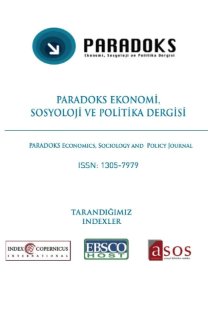TRANSFORMATION IN CHINA’S GLOBAL COMPETITIVENESS: FACTOR DENSITY AND PRODUCT-BASED APPROACH
China has become an important power in the global context in recent years with the added value it creates in the world. In this perspective, China has been an important economic threat in global markets for all developed and developing countries, particularly the United States and the EU. China, whose exports have grown year by year, also reflects quantitative developments in
Anahtar Kelimeler:
Competitiveness, Balassa Index, Vollrath Index, Factor Density, China
___
- Bakımlı, E. (2011). Türkiye İmalat Sanayi ve Alt Sektörlerinin Uluslararası Rekabet Gücü: Mevcut Durum ve Potansiyel Analizi. Yayınlanmamış Doktora Tezi,. Muğla: Muğla Üniversitesi Sosyal Bilimler Enstitüsü.
- Balassa, B. (1965). Trade Liberalization and Revealed Comparative Advantage. The Manchester School of Economic and Social Studies, 33(2), 99-123.
- Balassa, B., & Nordan, M. (1989). Revealed Comparative Advantage in Japan and the United States. Journal of International Economic Integration, 4(2), 8-22.
- Commission of The European Communities. (2002). Industrial Policy in an Enlarged Europe. Brussels: The Economic And Social Committee and the Committee of the Regions.
- Erkan, B. (2016). Türkiye’nin Canlı Hayvan, Et ve Deniz Ürünleri İhracatındaki Rekabet Gücünün Analizi. İnsan ve Toplum Bilimleri Araştırmaları Dergisi, 5(7), 1843-1864.
- Erkan, B., & Sarıçoban, K. (2014). Comparative Analysis of the Competitiveness in the Export of Science-Based Goods Regarding Turkey and the EU+13 Countries. Journal of Business and Social Science, 5(8), 117-130.
- Faustino, H. (2008). Intra-Industry Trade and Revealed Comparative Advantage: An Inverted-U Relationship. SOCIUS Working Paper.
- Hinloopen, J. (2001). On the empirical distribution of the Balassa Index. Review of World Economics, 137(1), 1-49.
- Hufbauer, G.J., & Chilas, J.G. (1974). Specialization by Industrial Countries: Extent and Consequences, The International Division of Labour: Problems and Perspectives-International Symposium, Germany, 3-38.
- http://www.statistics.com/resources/glossary/t/trimmean.php. (15.03.2021).
- http://wits.worldbank.org/WITS/WITS/AdvanceQuery/RawTradeData/QueryDefinition.aspx?Page=RawTradeData, (15.03.2021).
- https://data.worldbank.org/country/china?view=chart. (15.03.2021).
- Kara, O., Erdoğan, N., & Erkan, B. (2018). The Power of Competitiveness of the Toy Sector in Turkey and the Neccesity of Specialized Toy Organised Industrial Zones. A. Oğuz, Global and Regional Studies in Terms of Economical and Social Issues I., Almaty: Al-Farabi Kazakh National University.
- Kibritçioğlu, A. (1996). Uluslararası Rekabet Gücü’ne Kavramsal Bir Yaklaşım. MPM Verimlilik Dergisi, 96(3), 109-122.
- Lederman, D., Olarreaga, M., & Rubiano, E. (2006). Latin America’s trade specialization and China and India’s growth.
- http://siteresources.worldbank.org/INTLACOFFICEOFCE/Resources/LACspecializationpattern.pdf Lei Liu1, Y. W., Wang, M.-Q., Xiao, Y.-B., & Gao, M. (2017). Research on the competitiveness of high-tech industries in northeast China . 3rd International Conference on Advances in Energy, Environment and Chemical Engineering . Guangzhou: AEIC.
- Mykhnenko, V. (2005). What Type of Capitalism in Eastern Europe?Institutional. Conference on Varieties of Capitalism in Post Communist Countries, Paisley, Scotland: Centre for Contemporary European Studies.
- Porter, M. E. (1991). Towards a dynamic theory of strategy. Strategic Management Journal, 12, 95-117.
- Sarıçoban, K. (2016). Ülkelerin ihracat rekabet güçlerinin belirlenmesi: Türkiye ve G-20 ülkelerinin karşılaştırmalı analizi. Sosyal Bilimler Enstitüsü İktisat Ana Bilim Dalı Doktora Tezi, 1-433. Isparta, Türkiye: Süleyman Demirel Üniversitesi.
- Saxena, S. B., & Director, A. (2010). Competitiveness in the Garment and Textile Industry: Creating a Supportive Environment: A Case Study of Bangladesh. The Asian Foundation.
- Schoot, P. K. (2006). The Relative Competitiveness of China's Export to the United States vis a vis Other Countries in Asia, the Caribbean, Latin America and the OECD. Buenos Aires: INTER-American Development Bank.
- Shioji, H. (2012). Competitiveness of the Japanese, Korean, and Chinese Automobile Industries. The Kyoto Economic Review, 81(1), 48-63.
- Vollrath, T. (1991). A Theoretical Evaluation of Alternative Trade Intensity Measures of Revealed Comparative Advantage. Review of World Economics, 127(2), 265-280.
- Voon, J. P. (1998). Export Competitiveness of China and ASEAN in the U.S. Market. ASEAN Economic Bulletin, 14(3), 273-291.
- Wu, Z., & Thomson, K. (2003). Changes in Chinese Competitiveness in Major Food Products: Implications for WTO Membership. Journal of Chinese Economic and Business Studies, 1(1), 117-130.
- Zhang, W., & Zhang, T. (2005). Competitiveness of China's Manufacturing Industry and its Impacts on the Neighbouring Countries. Journal of Chinese Economic and Business Studies, 3(3), 205-229.
- ISSN: 1305-7979
- Yayın Aralığı: Yılda 2 Sayı
- Başlangıç: 2005
- Yayıncı: Sema AY
